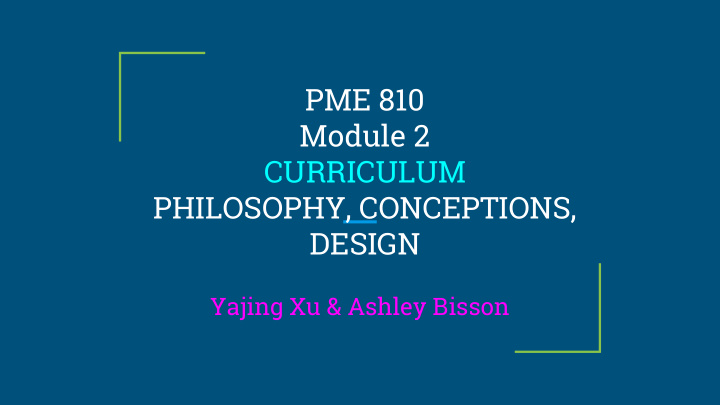



PME 810 Module 2 CURRICULUM PHILOSOPHY, CONCEPTIONS, DESIGN Yajing Xu & Ashley Bisson
Humanistic Curriculum Social Reconstructionist Conceptions Skills, Technological Academic
Curriculum Philosophy Perennialism Essentialism Progressivism Reconstructionism
Connection: Conception - Philosophy Conception Philosophy Humanistic Perennialism (Realism) Social Reconstructionist Essentialism (Idealism, Realism) Skills, Technological Progressivism (Pragmatism) Academic Reconstructionism (Pragmatism)
How Do They Relate? Progressivism Perennialism Essentialism Reconstructionism The Humanistic conception of The Academic conception of The Skills and Technological The Social Reconstructionism curriculum focuses on curriculum is very much conception of curriculum conception of curriculum aims developing the individual as a focused on developing a focuses on the delivery of to develop students in such a person. student’s knowledge, and content and how educators can way to advocate change for focusing on the subject and incorporate technology as the society. The focus of curriculum academia being taught. main delivery component. In surrounds societal change. As Ornstein describes, with the addition, these conceptions of Perennialism philosophy of curriculum place an emphasis curriculum, also referred to as a The Essentialism philosophy of The Reconstructionism on fostering student realism approach, the teacher’s education focuses on the philosophy’s objective is to development in regards to a role is to help the student think basics of education, the reconstruct society towards technologically advancing rationally, develop a student’s content, and the student’s ability improvement (p.105) society. intellect and values (p. 105) to succeed in subjects (p. 105) The Progressivism focuses on current societal happenings (i.e.) technology) (p. 105)
Curriculum Design Subject-Centered Learner-Centered Problem-Centered ● ● ● Designs Designs Designs child-centered designs, subject designs, life situations, experience-centered discipline designs, core designs, designs, broad field designs, Social problem/ romantic/radical correlation designs, Reconstructionist designs. designs, process designs humanistic designs.
Sources of Curriculum Design ● Science As A Source ● Society As A Source Moral Doctrine As A Source ● Knowledge As A Source ● ● The Learner As A Source
Conceptual Framework ● Horizontal Organization : Blends curriculum elements ● Vertical Organization: Refers to the sequencing of curriculum elements
Design Dimensions Considerations ● Scope: a curriculum’s breadth and depth of content ● Sequence: simple to complex, prerequisite, whole to part, chronological ● Continuity: vertical repetition of curriculum components. ● Integration : linking all types of knowledge and experiences contained within the curriculum plan. Balance: giving appropriate weight to each aspect of the ● design Articulation : the vertical and horizontal interrelatedness of various aspects of ● the curriculum
Connection: Conception - Curriculum Design Conception Curriculum Design Humanistic Learner-Centered Design Social Reconstructionist Subject-Centered Design Technological Problem-Centered Design Academic
How Do They Relate? ● Subject-Centered Learner-Centered ● Problem-Centered ● Designs Designs Designs The Academic conception of curriculum The Humanistic The Social Reconstructionism conception is very much focused on developing a conception of curriculum of curriculum aims to develop students in student’s knowledge, and focusing on the focuses on developing the such a way to advocate change for subject and academia being taught. individual as a person. society. The focus of curriculum surrounds societal change. Subject-centered designs focuses on the Learner-centered designs knowledge and content. This designs suggested that students Problem-centered designs focuses on the suggests that content is central to are the program’s focus real-life problems of individuals and schooling. society. It is based on social issues and places students within a social setting.
Connection: Philosophy-Conception-Design Curriculum Philosophy Design Conceptions Perennialism (Realism) Humanistic Learner-Centered Design Social Reconstructionist Essentialism (Idealism, Realism) Subject-Centered Design Technological Progressivism (Pragmatism) Problem-Centered Design Academic Reconstructionism (Pragmatism)
References: ● Ornstein, A. C. (1990/1991). Philosophy as a basis for curriculum decisions. The High School Journal, 74, 102-109. ● Ornstein, A. C., & Hunkins, F. P. (2013). Curriculum: Foundations, principles, and issues (6 th ed.). Boston, MA: Pearson. Read Chapter 6, pp. 149-173. ● Samuelsson, I. P., Sheridan, S., & Williams, P. (2006). Five preschool curricula—comparative perspective. International Journal of Early Childhood, 38(1), 11. ● Sowell, E. J. (2005). Curriculum: An integrative introduction (3rd ed., pp. 52-54, 55-61, 81-85,103-106). Upper Saddle River, NJ: Pearson
Recommend
More recommend